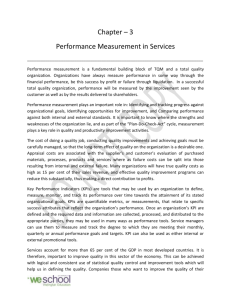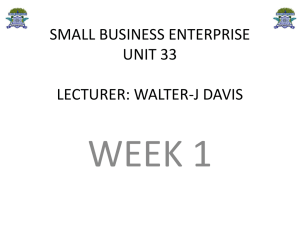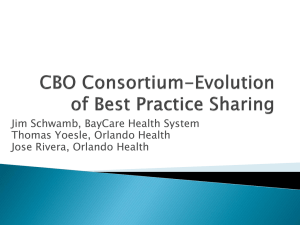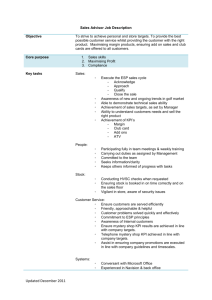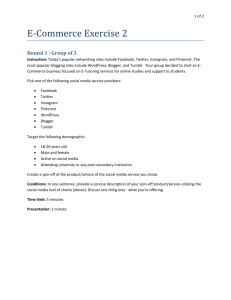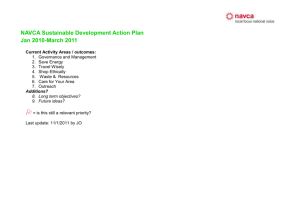4/1/13 Report
advertisement
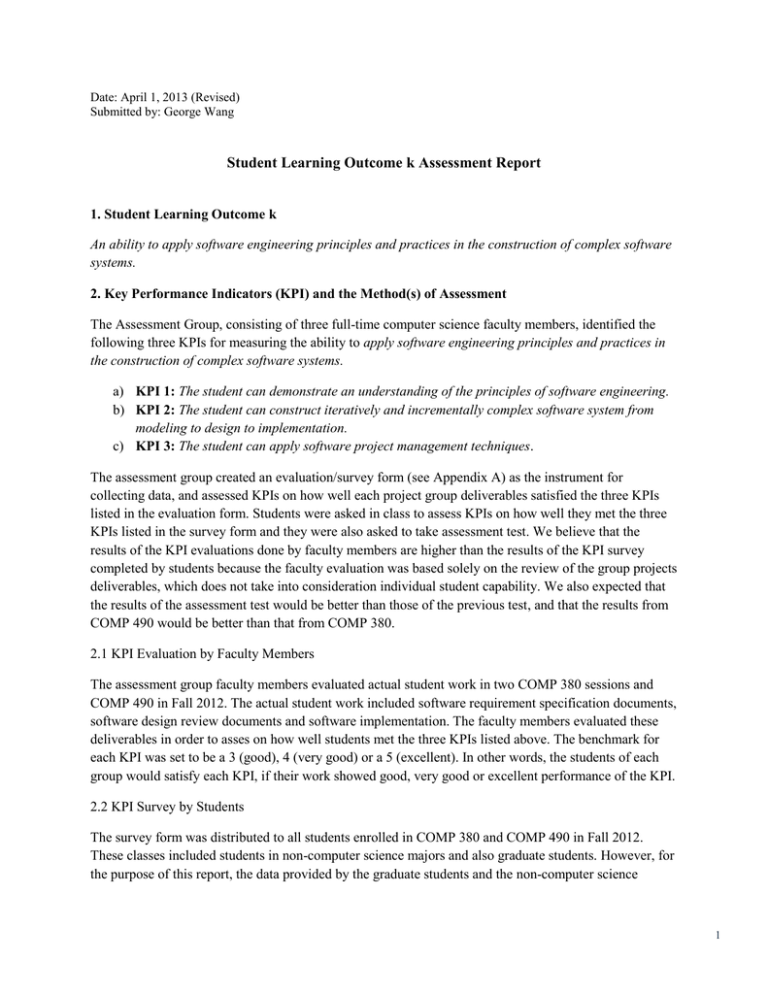
Date: April 1, 2013 (Revised) Submitted by: George Wang Student Learning Outcome k Assessment Report 1. Student Learning Outcome k An ability to apply software engineering principles and practices in the construction of complex software systems. 2. Key Performance Indicators (KPI) and the Method(s) of Assessment The Assessment Group, consisting of three full-time computer science faculty members, identified the following three KPIs for measuring the ability to apply software engineering principles and practices in the construction of complex software systems. a) KPI 1: The student can demonstrate an understanding of the principles of software engineering. b) KPI 2: The student can construct iteratively and incrementally complex software system from modeling to design to implementation. c) KPI 3: The student can apply software project management techniques. The assessment group created an evaluation/survey form (see Appendix A) as the instrument for collecting data, and assessed KPIs on how well each project group deliverables satisfied the three KPIs listed in the evaluation form. Students were asked in class to assess KPIs on how well they met the three KPIs listed in the survey form and they were also asked to take assessment test. We believe that the results of the KPI evaluations done by faculty members are higher than the results of the KPI survey completed by students because the faculty evaluation was based solely on the review of the group projects deliverables, which does not take into consideration individual student capability. We also expected that the results of the assessment test would be better than those of the previous test, and that the results from COMP 490 would be better than that from COMP 380. 2.1 KPI Evaluation by Faculty Members The assessment group faculty members evaluated actual student work in two COMP 380 sessions and COMP 490 in Fall 2012. The actual student work included software requirement specification documents, software design review documents and software implementation. The faculty members evaluated these deliverables in order to asses on how well students met the three KPIs listed above. The benchmark for each KPI was set to be a 3 (good), 4 (very good) or a 5 (excellent). In other words, the students of each group would satisfy each KPI, if their work showed good, very good or excellent performance of the KPI. 2.2 KPI Survey by Students The survey form was distributed to all students enrolled in COMP 380 and COMP 490 in Fall 2012. These classes included students in non-computer science majors and also graduate students. However, for the purpose of this report, the data provided by the graduate students and the non-computer science 1 majors were excluded. Thus, the results apply only to undergraduate students majoring in Computer Science. The benchmark for each KPI was set to be a 3 (good), 4 (very good) or a 5(excellent). In other words, the students of each group would satisfy the requirements for each KPI if their work showed good, very good or excellent performance of the KPI. 2.3 Assessment Test In addition to the student survey and the faculty evaluation of student work, we also used an assessment test to evaluate KPI 1. This same test was also used in May 2007 and February 2006 for the previous assessment on “SLO 10” which is “demonstrate an understanding of the principles and practices for software design and development.” Using the same test allows us to make comparisons among the students who took the test in 2006, 2007, as well as this year. The test was administered in COMP 380 and COMP 490 classes in Fall 2012. Forty-nine (49) undergraduate students majoring in computer science took the test. The test consisted of twenty multiple choice questions covering a broad range of topics from COMP 380 and COMP 490. A linear process model with five phases was used to assess KPI 1. The following are the five steps of the assessment process: Develop assessment test questions Develop scoring rubrics for the assessment of KPI 1 Conduct the assessment test in COMP 380 and COMP 490 Analyze the test results Produce an assessment report Before conducting the assessment test, the scoring rubrics were established as follows: Poor (0 – 6): Evidence that the student has mastered this learning objective is not provided, unconvincing, or very incomplete. Weak (7 – 11): Evidence that the student has mastered this objective is provided, but it is weak or incomplete. Adequate (12 – 16): Evidence shows that the student has generally attained this objective. Good (17 – 20): Evidence demonstrates that the student has mastered this objective at a high level. The benchmark for the assessment test was set to be “adequate” or “good.” In other words, students who performed at this level would have satisfied KPI 1. Assessment test questions are shown in Appendix C. 3. Results of the Assessment 3.1 Results of the KPI Evaluation by Faculty Members The overall assessment results, measured in all classes by faculty members, are summarized in Table 1. Using the criteria that a satisfactory KPI score is a 3 or above, this table indicates that, 91.1% of the aggregated responses met the criteria. 2 Range 3-5 1,2 N=15 KPI 1 86.7% 13.3% KPI 2 100.0% 0.0% KPI 3 86.7% 13.3% Agg. % 91.1% 8.9% Table 1: Percentages by KPIs evaluated by faculty members 3.2 Results of the Student KPI Survey The overall assessment results, measured in all classes, are summarized in Table 2. Using the criteria that a satisfactory KPI score is a 3 or above, this table indicates that 86.7% of the aggregated responses met the criteria. Range 3-5 1,2 N=50 KPI 1 86.0% 14.0% KPI 2 90.0% 10.0% KPI 3 84.0% 16.0% Agg. % 86.7% 13.3% Table 2: Percentages by KPIs surveyed by students 3.3 Analysis of Assessment Test The overall assessment test results, measured in all classes, are summarized in Table 3. Using the criteria that a satisfactory assessment test result is a 12 or above (out of 20), this table indicates that 59.2% of the test results met the criteria. The average score of the assessment test is 12.1. Poor (0-6) 0.0% N=49 Weak (7-11) 40.8% Adequate (12-16) 51.0% Good (17-20) 8.2% Table 3: Percentages of Assessment Test 4. Analysis of the Assessment Results 4.1 Analysis of the Results of the KPI Evaluation by Faculty Members Measurements showing performance in the individual KPIs are shown in Table 4. KPI 1: The question for KPI 1 asked whether the students “can demonstrate an understanding of the principles of software engineering.” 86.7% of the faculty evaluation indicates that KPI 1was satisfied, with 13.3% of the evaluation falling below the benchmark 3-5 range. KPI 2: The question for KPI 1 asked whether the students “construct iteratively and incrementally complex software system from modeling to design to implementation.” 100% of the faculty evaluation indicates that KPI 2 was satisfied. The assessment results indicate that performance is strongest in this KPI. 3 KPI 3: The question for KPI 3 asked whether the students “can apply software project management techniques.” Like the results in KPI 1 performance, 86.7% of the faculty evaluation indicates that KPI 3was satisfied, with 13.3% of the evaluation falling below the benchmark 3-5 range. 5 (excellent) 4 (very good) 3 (good) 2 (fair) 1 (poor) N=50 KPI 1 26.7% 40.0% 20.0% 13.3% 0.0% KPI 2 20.0% 60.0% 20.0% 0.0% 0.0% KPI 3 26.7% 46.7% 13.3% 13.3% 0.0% Agg. % 24.4% 48.9% 17.8% 8.9% 0.0% Table 4: Percentages by individual KPIs evaluated by faculty members - COMP 380 and COMP 490 (N=15) The evaluation results, measured in each class, are given in Appendix B.1. 4.2 Analysis of the Results of the Student KPI Survey Measurements showing performance in the individual KPIs are shown in Table 5. KPI 1: The question for KPI1 asked whether the students “can demonstrate an understanding of the principles of software engineering.” 86% of the responses indicate that KPI 1was satisfied, with 14% of the responses falling below the benchmark 3-5 range. KPI 2: The question for KPI2 asked whether the students “can construct iteratively and incrementally complex software system from modeling to design to implementation.” 90.0% of the responses indicate that this KPI was satisfied. The assessment results indicate that performance is strongest in this KPI, with10.0% of the responses falling below the benchmark 3-5 range. KPI 3: The question for KPI1 asked whether the students “apply software project management techniques.” 84% of the responses indicate this KPI was satisfied. The assessment results indicate that performance is weakest in this KPI, with 16% of the responses falling below the benchmark 3-5 range. 5 (excellent) 4 (very good) 3 (good) 2 (fair) 1 (poor) N=50 KPI 1 20.0% 34.0% 32.0% 14.0% 0.0% KPI 2 22.0% 24.0% 44.0% 6.0% 4.0% KPI 3 8.0% 34.0% 42.0% 12.0% 4.0% Agg. % 16.7% 30.7% 39.3% 10.7% 2.6% Table 5: Percentages by KPIs surveyed by students - Comp 380 and Comp 490 (N=50) The assessment results, measured in each class, are given in Appendix B.2. 4 4.3 Analysis of the Comparison between Faculty Evaluation Results and Student Survey Results 4.3.1 Based on the criteria Figure 1 shows the comparison between the faculty evaluation and the student survey results based on the criteria that a satisfactory KPI score is a 3 or above. The assessment results for all three KPI are similar between the faculty evaluation and student survey results. This observation indicates that students feel that they are familiar with software development (including modeling, design and implementation) in an iterative and incremental way, and the faculty members are satisfied with the way students developed software systems. However, both students and faculty members seem to share the belief that students need to spend more time learning of the principle of software engineering, as well as how to improve their software project management skills. Students should keep in mind that “Good management cannot guarantee project success. However, bad management usually results in project failure.” 100.00% 3-5 Faculty Evaluation 80.00% 60.00% 3-5 Student Survey 40.00% 1,2 Faculty Evaluation 20.00% 1,2 Student Survey 0.00% KPI 1 KPI 2 KPI 3 Agg. % Figure 1: Comparison between the faculty evaluation and student survey results based on the criteria 4.3.2 Based on the scale Figures 2(a)-(e) show the comparison between the faculty evaluation results and student survey results based on the individual scale, ranging from poor (1) to excellent (5). 30.00% 60.00% 25.00% 50.00% 20.00% 15.00% 10.00% 5.00% 0.00% 5 (excellentfaculty evaluation) 40.00% 5 (excellentstudent survey) 20.00% KPI 1 KPI 2 KPI 3 Agg. % Figure 2(a): Comparison between the faculty evaluation results and student survey results based on the scale 5 (excellent) 4 (very goodfaculty evaluation) 30.00% 10.00% 0.00% KPI 1 KPI 2 KPI 3 Agg. % 4 (very goodstudent survey) Figure 2(b): Comparison between the faculty evaluation results and student survey results based on the scale 4 (very good) 5 50.00% 16.00% 40.00% 3 (goodfaculty evaluation) 30.00% 20.00% 3 (goodstudent survey) 10.00% 0.00% 12.00% 2 (fairfaculty evaluation) 8.00% 2 (fairstudent survey) 4.00% 0.00% KPI 1 KPI 2 KPI 3 Agg. % KPI 1 KPI 2 KPI 3 Agg. % Figure 2(c): Comparison between the faculty evaluation results and student survey results based on the scale 3 (good) Figure 2(d): Comparison between the faculty evaluation results and student survey results based on the scale 2 (fair) 5.00% 4.00% 1 (poorfaculty evaluation) 3.00% 2.00% 1 (poorstudent survey) 1.00% 0.00% KPI 1 KPI 2 KPI 3 Agg. % Figure 2(e): Comparison between the faculty evaluation results and student survey results based on the scale 1 (poor) 4.4 Combined Results from the Faculty Evaluation and Student Survey Results The combined result from the faculty evaluation and student survey results is shown in Table 6. 5 (excellent) 4 (very good) 3 (good) 2 (fair) 1 (poor) KPI 1 23.4% 37.0% 26.0% 13.7% 0.0% KPI 2 21.0% 42.0% 32.0% 3.0% 2.0% KPI 3 17.4% 40.4% 27.7% 12.7% 2.0% Agg. % 20.6% 39.8% 28.6% 9.8% 1.3% Table 6: Combined results from the faculty evaluation and student survey results 6 4.5 Analysis of Assessment Test The average score of the assessment test was 12.1, which belongs to the acceptable rubric. Also, the average scores from COMP 380 and 490 were 11.6 and 12.6, respectively. Note that the acceptable category means that the student has generally attained this objective. This score shows in an increase in value compared to the average scores of the two previous assessment tests, 11.5 and 10.7. Table 7 shows the results of the test questions. Each entry is either a 1 (indicating a correct answer) or 0 (indicating an incorrect answer). The shaded column (Question 1) indicates that the question was answered correctly on less than 30% (“poor”) of the tests. Question 1 is reviewed next. Question 1. Cohesion is a measure of how closely the parts of a component relate to each other and coupling is a measure of the strength of component interconnections. Designers should aim to produce: A. strongly cohesive designs regardless of coupling B. weakly coupled designs regardless of cohesion C. strongly cohesive and strongly coupled design D. weakly cohesive and strongly coupled design E. strongly cohesive and weakly coupled design The answer is “strongly cohesive and weakly coupled design.” A significant number of students chose “strongly cohesive and strongly coupled design.” They either did not learn or forgot the concepts and relationships of cohesion and coupling. Cohesion refers to the degree to which the elements of a module belong together, and coupling is the degree to which each program module relies on other modules. Low coupling is often a sign of a well-structured software system and good design, and when combined with high cohesion, supports the general goals of high readability and maintainability. 7 Test Question # Test # 1 2 3 4 5 6 7 8 9 10 11 12 13 14 15 16 17 18 19 20 21 22 23 24 25 26 27 28 29 30 31 32 33 34 35 36 37 38 39 40 41 42 43 44 45 46 47 48 49 Total Avg. 1 1 0 0 0 0 0 0 0 0 0 0 0 0 0 0 0 0 0 0 0 0 1 0 0 1 0 1 1 0 0 1 0 0 1 0 0 0 0 0 0 1 1 1 0 1 1 0 0 0 12 24% 2 0 1 1 1 1 1 1 0 1 0 1 1 1 1 0 1 1 1 1 0 0 1 1 1 1 1 1 1 0 1 1 1 1 1 1 1 0 1 1 1 1 1 1 1 1 1 1 1 1 41 84% 3 0 0 0 0 0 1 1 0 0 1 1 1 1 0 1 0 0 1 0 0 0 0 1 1 0 1 0 0 0 0 0 1 0 0 1 0 1 0 0 0 1 0 1 1 1 1 0 0 1 20 41% 4 0 1 1 1 1 0 0 0 0 1 1 1 0 0 0 0 0 0 1 0 0 0 0 1 0 1 0 1 0 1 1 0 0 0 0 0 0 0 1 1 1 0 1 0 1 0 0 0 0 18 37% 5 1 0 0 0 0 0 0 0 1 1 1 0 1 0 0 0 0 0 1 0 1 0 1 1 0 0 1 0 0 1 1 1 0 1 1 0 1 1 1 1 1 1 1 1 1 0 1 1 1 27 55% 6 1 0 0 0 1 0 1 0 1 1 1 0 1 0 1 1 0 1 1 0 1 1 1 1 0 0 1 1 1 1 1 1 0 1 0 1 1 0 0 1 1 0 1 1 0 0 0 0 1 29 59% 7 1 1 1 1 0 0 0 0 1 1 0 1 0 0 1 0 0 0 1 0 1 1 1 1 1 1 1 1 1 1 0 0 1 1 0 1 0 1 1 1 0 0 1 0 0 0 0 0 0 26 53% 8 0 1 1 1 1 0 1 0 1 1 1 1 1 1 0 1 1 1 1 0 1 1 1 1 1 1 1 1 1 1 1 1 1 1 1 1 1 0 1 1 1 0 1 1 1 1 0 1 1 41 84% 9 1 1 1 0 1 0 0 0 0 0 1 0 0 0 0 0 0 1 1 1 1 1 1 0 1 1 1 0 1 1 1 1 0 0 0 0 1 0 0 0 1 1 0 1 1 0 0 1 1 25 51% 10 0 1 1 0 0 0 0 0 1 0 0 0 0 0 0 0 0 0 1 0 0 0 0 1 1 0 1 0 0 0 1 0 0 0 1 0 0 1 1 1 0 1 0 1 1 1 0 0 0 16 33% 11 1 1 1 0 0 1 0 0 0 1 0 0 0 0 0 0 0 0 0 1 0 1 0 1 1 0 1 1 1 1 1 1 1 0 1 1 0 1 0 1 1 1 0 0 1 1 1 1 0 26 53% 12 0 0 1 1 0 1 1 0 1 1 0 0 0 0 0 1 1 0 0 0 1 1 1 0 0 0 1 1 0 0 1 1 0 0 1 1 0 1 0 1 1 0 1 1 1 1 1 1 1 27 55% 13 1 1 1 1 1 1 1 1 1 1 1 1 0 1 0 1 1 0 1 0 1 0 1 0 1 0 1 0 1 1 1 0 1 0 0 1 1 0 0 1 1 0 1 0 1 1 1 0 1 33 67% 14 1 1 0 1 1 1 1 1 1 1 1 1 0 1 1 1 1 1 1 1 0 1 1 1 1 1 1 1 0 1 1 1 1 1 0 1 0 1 1 1 1 1 1 1 1 1 1 1 1 43 88% 15 1 1 1 1 1 1 1 1 1 1 1 1 1 1 1 1 1 0 1 1 1 1 0 1 1 1 1 1 1 1 1 1 1 0 1 1 0 1 1 1 1 1 1 0 1 1 0 1 0 42 86% 16 0 1 0 1 0 0 0 1 1 0 1 0 0 1 0 0 0 0 1 1 1 1 0 1 1 0 1 0 0 1 1 0 1 0 0 1 0 1 0 0 1 0 1 0 1 0 0 0 0 21 43% 17 1 1 0 1 1 0 0 0 1 1 1 1 1 1 0 1 1 0 0 0 1 0 1 1 1 1 0 0 1 1 1 1 2 0 0 0 1 0 1 1 1 1 1 0 1 1 0 1 1 33 67% 18 1 1 0 1 1 1 1 1 1 1 1 1 1 1 1 1 1 0 1 1 1 0 1 1 1 1 1 1 1 1 1 1 0 0 1 1 0 1 0 1 1 1 1 0 1 1 1 1 1 41 84% 19 1 1 1 0 1 1 1 1 0 0 1 0 1 1 0 0 0 1 1 1 1 1 1 1 1 1 1 1 1 1 1 1 0 0 1 1 0 1 0 1 0 1 0 0 0 1 0 1 1 33 67% 20 1 1 1 1 0 1 1 1 1 1 1 0 0 1 1 1 1 0 1 1 1 1 1 1 1 1 1 1 0 1 1 0 0 1 1 1 1 1 1 1 1 1 1 1 1 1 1 1 1 42 86% Total 13 15 12 12 11 10 11 7 14 14 15 10 9 10 7 10 9 7 15 8 13 13 14 16 15 12 17 13 10 16 18 13 10 8 11 13 8 12 10 16 17 12 16 10 17 14 8 12 13 12.2 Table 7: Assessment test question results 8 5. Numerical Summary of Results This section lists the percentages of students whose demonstration of this SLO was judged “poor”, “weak”, “adequate” or “good.” A student was counted as having met the student learning outcome if his/her performance was “adequate” or “good.” Note that the five rating scale that was used for KPI evaluation and assessment are transformed into a four rating scale, by mapping from “poor” to “poor”, “fair” to “week”, “good” to “adequate”, and “very good”/“excellent” to “good,” respectively. The numerical summary of results is shown in Table 8. Poor 1.3% Weak 9.8% Adequate 18.6% Good 60.4% Table 8: Numerical summary of results based on KPIs assessment Table 9 shows the numerical summary of results based on the assessment test focused on KPI 1. A student was counted as having met the student learning outcome if his/her performance was “adequate” or “good.” Poor (0-6) 0.0% Weak (7-11) 40.8% Adequate (12-16) 51.0% Good (17-20) 8.2% Table 9: Numerical summary of results based on assessment test on KPI 1 6. Recommendations for Actions/Changes: a. If this was an informal assessment, is there a need to perform formal assessment(s) with respect to this SLO? This was a formal assessment. b. If this was a formal assessment, should it be repeated? If so, when? Yes, annually. The next assessment is being planned for Fall 2014. c. Should changes be made in the way this assessment was done? If so, describe the changes. Ideally, faculty members would assess both individual student and group KPI. Conduct the survey with the help of automated tools such as Survey Monkey. Change the rating scale for the survey from a 1-5 rating scale (poor to excellent) to a 1-4 rating scale (poor to good) in order to make the survey rating scale consistency with numerical summary of the results. Change the wording for the measurement of KPI 3 to “rate your ability to apply software project management techniques such as scope definition, scheduling planning and management, cost estimation, and communication.” The added word is italicized. Replace or modify the question for which the percentage of correct answers was less than 30%. d. Should there be any changes in curriculum based on the results of this assessment? If so, describe recommended changes. The results of the faculty KPI evaluations and the student KPI surveys, shown in Table 4 and Table 5, point out that performance related to KPI 1 and KPI 3 was weaker than that for KPI 2. These results indicate that students should receive additional guidance on the principles of software engineering and software project management techniques. 9 e. Should any other changes be made? None recommended at this time. Appendix A Student Learning Outcome (SLO) k Assessment 1 - 2. Demographic Questions 1. What is your current student level? A. freshman B. sophomore C. junior D. senior E. graduate student 2. What is your current major? A. Computer Science B. Computer Information Technology C. Information System D. Computer Engineering E. Electrical Engineering F. Mathematics G. Others 3 - 5. Assessment of SLO k KPIs (Key Performance Index) SLO k: An ability to apply software engineering principles and practices in the construction of complex software systems. 3. KPI 1: You can demonstrate an understanding of the principles of software engineering. On a scale 1 (poor) - 5 (excellent), rate your ability to apply the principles of software engineering to the construction of complex software systems. The principles of software engineering include “make quality number one,” “give products to customers early,” “evaluate design alternatives,” “use an appropriate process model,” “design for change,” “use tools,” and “good management is more important than good technology.” A. poor B. fair C. good D. very good E. excellent 4. KPI 2: You can construct iteratively and incrementally complex software system from modeling to design to implementation. On a scale 1 (poor) - 5 (excellent), rate your ability to develop complex software systems iteratively and incrementally over the entire software development process period, taking advantage of what was learned during the development of earlier cycles or parts of the system. A. poor B. fair C. good D. very good E. excellent 10 5. KPI 3: You can apply software project management techniques. On a scale 1 (poor) - 5 (excellent), rate your ability to apply software project management techniques such as scope definition, scheduling planning and management, cost estimation, and communication. A. poor B. fair C. good D. very good E. excellent 11 Appendix B B.1 Faculty Evaluation Results, Measured in Each Class Group No. 1 2 3 4 5 6 7 8 9 10 KPI 1 KPI 2 KPI 3 4 5 5 5 4 4 4 4 5 5 4 4 4 5 3 4 3 3 4 2 4 4 4 4 3 5 4 4 4 2 Table 10: The results of KPIs evaluation using COMP 380 Fall 2012 student group project deliverables, conducted by Professors Nahapetian and Wang 5 (excellent) 4 (very good) 3 (good) 2 (fair) 1 (poor) N=10 KPI 1 30.0% 40.0% 20.0% 10.0% 0.0% KPI 2 20.0% 70.0% 10.0% 0.0% 0.0% KPI 3 20.0% 60.0% 10.0% 10.0% 0.0% Agg. % 23.3% 56.7% 13.3% 6.7% 0.0% Table 11: Percentages by KPIs evaluation using COMP 380 Fall 2012 student group project deliverables, conducted by Professors Nahapetian and Wang Group No. 1 2 3 4 5 KPI 1 KPI 2 KPI 3 5 2 4 4 3 5 3 4 4 3 5 2 4 5 3 Table 12: The result of KPIs evaluation using COMP 490 Fall 2012 student group project deliverables, conducted by Professor Wang 12 5 (excellent) 4 (very good) 3 (good) 2 (fair) 1 (poor) N=5 KPI 1 20.0% 40.0% 20.0% 20.0% 0.0% KPI 2 20.0% 40.0% 40.0% 0.0% 0.0% KPI 3 40.0% 20.0% 20.0% 20.0% 0.0% Agg. % 26.67% 33.33% 26.67% 13.33% 0.00% Table 13: Percentages by KPIs evaluation using COMP 490 Fall 2012 student group project deliverables, conducted by Professor Wang B.2 Student Survey Results in Measured in Each Class 5 (excellent) 4 (very good) 3 (good) 2 (fair) 1 (poor) N=29 KPI 1 20.7% 34.5% 27.6% 17.2% 0.0% KPI 2 24.1% 17.2% 44.8% 6.9% 6.9% KPI 3 6.9% 51.7% 27.6% 6.9% 6.9% Agg. % 17.2% 34.5% 33.3% 10.3% 4.6% Table 14: Percentages by KPI - COMP380 (N=29) 5 (excellent) 4 (very good) 3 (good) 2 (fair) 1 (poor) N=21 KPI 1 19.0% 33.3% 38.1% 9.5% 0.0% KPI 2 19.0% 33.3% 42.9% 4.8% 0.0% KPI 3 9.5% 9.5% 61.9% 19.0% 0.0% Agg. % 15.9% 25.4% 47.6% 11.1% 0.0% Table 15: Percentages by KPI - COMP490 (N=21) 13 C. Assessment Test COMP 380 Assessment Test 30 minutes 1 - 2. Demographic Questions 1. What is your current student level? A. freshman B. sophomore C. junior D. senior E. graduate student 2. What is your current major? A. Computer Science B. Computer Information Technology C. Information System D. Computer Engineering E. Electrical Engineering F. Mathematics G. Others 1 - 20. Assessment Questions 1. Cohesion is a measure of how closely the parts of a component relate to each other and coupling is a measure of the strength of component interconnections. Designers should aim to produce: A. strongly cohesive designs regardless of coupling B. weakly coupled designs regardless of cohesion C. strongly cohesive and strongly coupled design D. weakly cohesive and strongly coupled design E. strongly cohesive and weakly coupled design 2. If a new development method is more efficient than the previous one, it still might not be adopted. A possible reason for this is: A. There is a comparatively large initial cost outlay. B. Due to the significant learning curve associated with the new product/technique, there will be a delay in getting new projects started. C. The new technique may produce code that is more difficult to maintain than the old. 14 D. All of the above (A, B, C) may be valid reasons for not adopting the new technique. E. None of the above (A, B, C) is good reasons for not adopting the new and more efficient technique. 3. Which of the following is an advantage of top-down implementation and integration? A. Potentially reusable code artifacts are adequately tested B. Major design flaws show up early when the logic modules are coded and tested C. Testing is done with the aid of drivers D. All of these (A, B, C) are advantages E. None of these (A, B, C) is advantages 4. The typical elements of the requirements engineering process are: I. problem analysis II. software design III. analysis of staffing needs IV. external behavior specification A. I and IV B. II and III C. I, III, and IV D. I, II, and III E. I only 5. Why should the SQA group be kept under separate management from the development team(s)? A. to increase the employment prospects of the analysts. B. to make sure that top performers from the other teams are promoted to the SQA group for the purpose of checking the work of others. C. to decrease the cost of managing large teams D. to facilitate the principle of information hiding that is crucial to object-oriented systems E. to avoid conflicts that may arise as production deadlines approach whilst the product still has serious faults. 6. In the case of code inspection the most appropriate measure of fault density is A. the number of major/minor faults detected per hour B. the number of major/minor faults detected per person-hour C. the number of faults detected during inspection versus the number found in production once the product was put into operation D. the number of faults detected per 1000 lines of code (KLOC) E. the number of faults detected per page per hour 7. During which phase of the Waterfall software project life-cycle model should testing (execution or non-execution testing) occur? A. integration B. validation 15 C. testing occurs during each phase D. maintenance E. implementation 8. Which UML diagram best emphasizes the chronological order of messages? A. class diagram B. sequence diagram C. collaboration diagram D. activity diagram E. use case diagram 9. In object-oriented analysis, a CRC card contains: A. constraints, requirements and containers B. classes, responsibilities and collaborators C. conditions, relationships and code D. cohesion, review and consistency E. none of the above 10. Which of the followings is NOT a problem in the development of reusable software? A. increased dependability B. lack of tool support C. not-invented-here syndrome D. creating and maintaining a component library E. finding, understanding and adapting reusable components 11. Suppose you have a software routine that controls a temperature sensor that drives a warning light on an airplane to notify the pilot of potential icing problems. The specification says that this light is to glow red whenever the temperature is strictly less than –20 degrees Celsius, yellow between –20 and 10 degrees Celsius (inclusive), and green for all temperatures strictly greater than 10 degrees Celsius. What is the minimum number of test cases needed to achieve black box testing based on equivalence class and boundary values? A. 2 B. 3 C. 6 D. 8 E. 9 12. Which of the following statements are myths (misunderstanding) about software products and projects? I. If we get behind a schedule, we can add more programmers and catch up. II. A general statement of objectives is sufficient to begin writing programs – we can fill in the details later. 16 III. Project requirements continually change, but change can be easily accommodated because software is flexible. IV. The only deliverable work product for a successful project is the working program. V. Given the same requirements, every institution creates different products: even the same institution creates different products (in terms of design and implementation) over the different periods of time. A. All B. I, II, III, V C. II, III, IV, V D. I, II, IV, V E. I, II, III, IV 13. At which stage of the product's life-cycle should documentation be produced? A. testing, as it is only here that the technical writers can see what has been built and document it. B. maintenance, as this is the first phase when it is required in order to fix faults or make enhancements. C. throughout the project D. at no stage, the use of modern techniques such as extreme testing obviates the need for any documentation. E. specification, as it is needed to produce test cases for acceptance testing. 14. Problems with using Lines of Code to measure the size of a product include: A. the creation of source code is only part of the development effort B. the Lines of Code (LOC) will differ between languages and cannot be measured for some languages C. should comments, data definitions etc. (i.e. non-executable LOC) be included as well? D. the final size (KLOC) can only be determined once the product is delivered E. all of the above (A, B, C, D) 15. Among extreme programming features, _________ changes a software system so that it doesn’t alter the code’s external behavior yet improves its internal structure. A. stand-up meeting B. refactoring C. maintenance D. test-driven development E. pair programming 16. In a large real-time systems project, the following items (or components) of the system were included in the component list produced as part of the architectural design: I. Input signal pre-processing II. Main control processing III. Network interfacing In which component(s) would the non-functional requirement of reliability be? A. I 17 B. I and II C. I and III D. II and III E. I, II and III 17. During which phase of the software life cycle do you first consider maintenance? A. implementation B. testing C. maintenance D. from the very beginning of the software life cycle E. design 18. The process of starting with the source code and recreating the design documents or even the specifications is known as: A. reverse engineering B. re-engineering C. forward engineering D. restructuring E. debugging 19. If a product is to be ported to different machines then different versions are called: A. variants B. baseline C. release D. regression E. revision 20. Which of the following types of errors would you NOT expect to uncover during “unit testing”? A. an incorrect logical operator in a decision statement B. an improper or nonexistent loop termination C. a missing functional requirement D. an incorrectly typed variable E. the failure to initialize a variable 18
